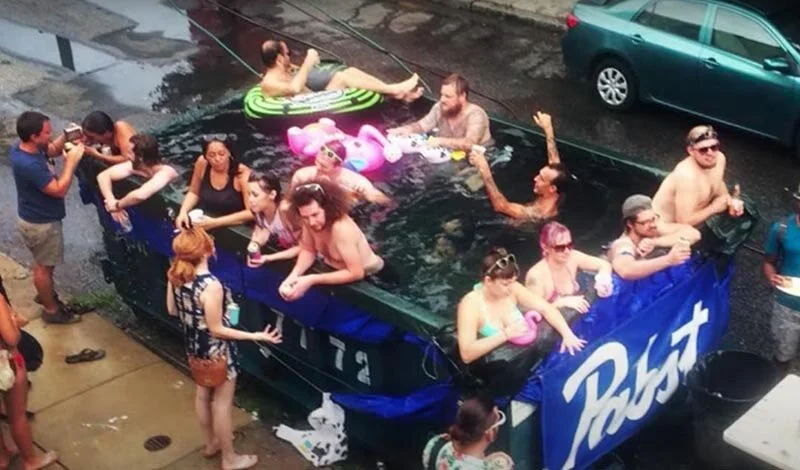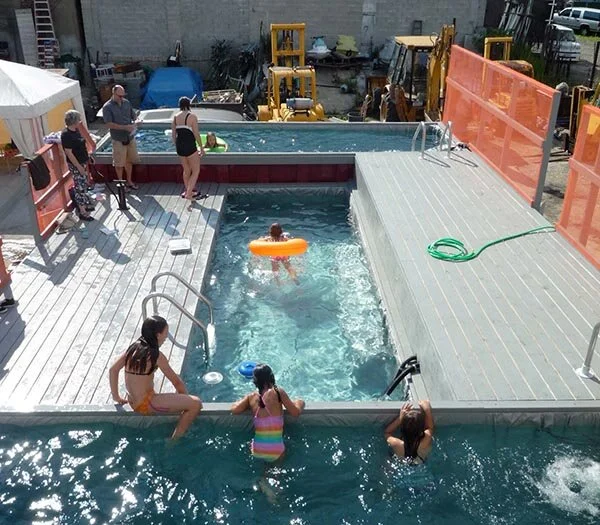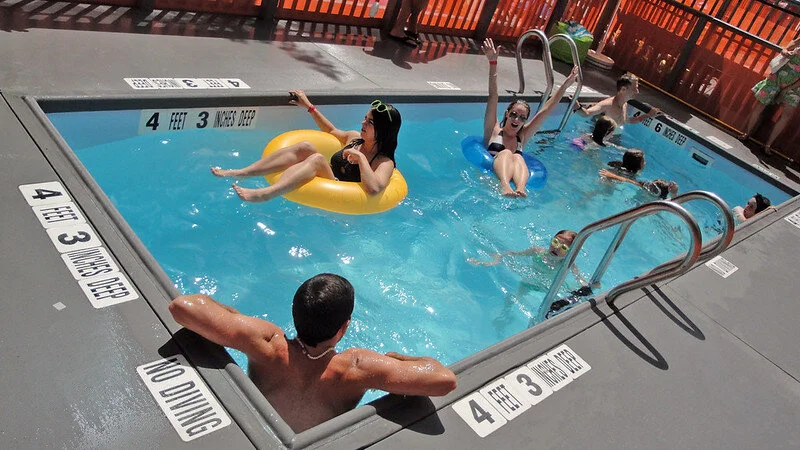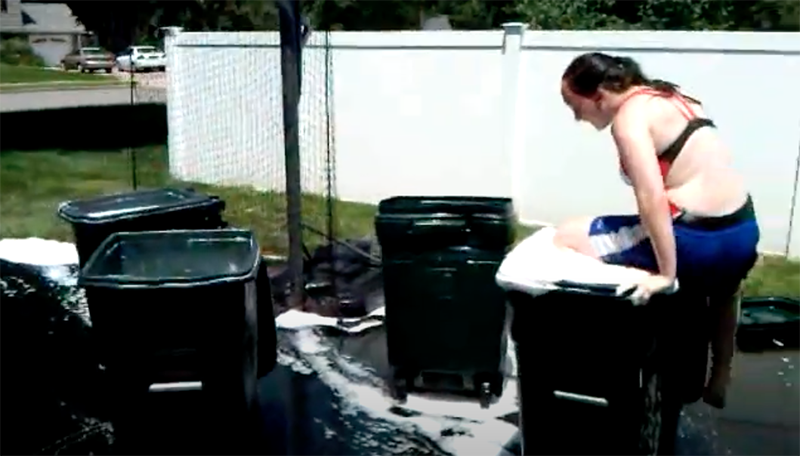A Short History Of Dumpster Pools
Have trash can, will swim.
By Jessie Schiewe
Refreshing or repulsive? (Credit: Screenshot)
Cedar Street in Philadelphia is not particularly long. Only about eight city blocks in length, it’s only a short walk to the shores of the Delaware River and, beyond that, New Jersey. Flanked with brick rowhouses packed so tightly nary an inch of space exists between one home and the next, the street also boasts a handful of restaurants and grocery stores, as well as a recreation center.
Most Philadelphians know of Cedar Street, or have at least heard of it. But its local notoriety has nothing to do with the homes, buildings, or businesses found along it. It’s connected to something less permanent, more ephemeral, and much cooler: the Cedar Street Block Party.
Happening every summer since at least 2012 — and likely well before that — the Cedar Street Block Party is a joyous, if not hedonistic day-long celebration where booze, bros, bikinis, and bouncy houses reign, with each year seemingly more outrageous than the last. On one occasion, the Cedar Street Block Party played host to an antique rummage sale. Another time, it hosted a Beerlympics.
But, to date, no block party has been as memorable as 2016’s. Though swimming and water sports are central tenets at every block party, that year was more wet and wild than usual.
Why? Because they turned a dumpster into a swimming pool.
The famed dumpster pool at the 2016 Cedar Street Block Party. (Credit: Screenshot)
The unveiling of the dumpster pool did not come totally out of the blue. At the block party the year before, a pickup truck had been converted into a pool. Doing the same thing the next year, but with an industrial-sized trash can was a logical next step, especially given the container’s expanded depth and space.
After an initial power washing of its interior, the dumpster pool was relatively simple to construct. Plywood boards were used to line the bottom, with pool noodles cushioning the corners. On top of that, a pair of Home Depot tarps were draped, with the addition of water from a nearby fire hydrant as the final step. After that, the dumpster pool was ready for its first bathers.
“Everybody that was there thought it was the best idea ever,” Justyn Myers, one of the block party’s organizers, told USA Today in 2016. “They were like: ‘I can’t believe that we haven’t done this before!’ ”
It’s hard to say who first came up with dumpster pools, but the idea has been around since before the epic 2016 Cedar Street Block Party. The latest reference OK Whatever found dates back to April 2009, when the musician Curtis Crowe, who drums in the rock band Pylon, made one for his Athens, Georgia home. By chance, a New Yorker named David Belt happened to be in the area during that time and saw the ingenious creation. After a brief conversation with Crowe, Belt decided to “borrow” the idea and brought it up north.
A few months later, right in time for summer, Belt achieved his goal. Through his development company Macro-Sea, Belt, his wife, and a handful of Craigslist-sourced designers transformed a junkyard in Brooklyn into a temporary country club, replete with cabanas, lounge chairs, a bocce court, and, of course, dumpster pools.
Macro-Sea’s dumpster pools in Brooklyn, 2009. (Credit: Macro-Sea)
Belt obtained the dumpsters for free from a construction company that had a surplus of them. Their insides were cleaned, lined in plastic, and then a filtration system, similar to what you’d find on a regular above-ground pool, was installed. The water came last. Sourced from a New Jersey aquifer and purchased for $1,200, Belt ordered about 18,000 gallons of the stuff.
“The water’s amazingly fresh for swimming in a dumpster,” a TriBeCa-based filmmaker told the New York Times after taking a dip in one of the pools.
Belt’s dumpster pools were a hit — not just with residents, but with city planners. New York City officials noticed how popular they were and easy to set up and decided to bring the concept to Manhattan the following year. In 2010, as part of the city’s Summer Streets program, three dumpsters along Park Avenue were transformed into swimming pools for local residents to use over three Saturdays that August.
The following year, dumpster pools cropped up in Long Island City. The Palms, a now-closed event venue, seized the idea and began throwing dumpster pool parties on Saturdays, charging bathers $10 to $20 for a dip. Hammocks were strung, fancy striped beach towels were acquired, and eclectic fusion music was spun during each weekend event, which was always packed, with a line snaking out the door.
One of the dumpster pools in New York City during 2010. (Credit: Flickr/Katie K)
If the dumpster pool trend has taught us anything, it’s that when it’s hot outside, people will do seemingly anything to get cool — even if that means swimming in a container that once held rotting, stinking trash. It seems that anything can be made chic with the right decorations, although the origin of dumpster pools likely stemmed from a more utilitarian concept. If it’s true that necessity begets invention, then countless people throughout recent history who have lacked pools of their own or nearby bodies of water to plunge into have also probably made dumpster pools.
In an early episode from “The George Lopez Show,” the comedian joked about how he learned how to swim in a trash can.
“I had to swim in a garbage can in my underwear. You want to see how I did laps? One, two, three, four. One, two, three, four,” he demonstrated. “And I’d do the butterfly. One, two, three, four. And my friends would drive by, and I’d be embarrassed. I would close the lid.”
Even residential-sized trash cans are not too small to be turned into pools. YouTube abounds with videos of people pouring garden hoses into their city-issued recycling and waste containers before jumping in. There’s a video of a brother and sister who, after being “forced to clean trash cans for chores,” decided to enjoy the fruits of their labor by climbing into their freshly-washed, bubbly interiors. Kids seem to be particularly fond of them, likely due to their smaller sizes. In one video, a grumpy, fully-clothed tween soaking in a green garbage can yells and splashes water on the person filming them, proclaiming, “This is my pool, bitch. Move, bitch!” before begging for help getting out.
Credit: Screenshot
Dumpster pools aren’t for everyone. Those with a large bodily mass or an aversion to germs likely won’t be basking in them any time soon. And people who don’t have a garden hose probably shouldn’t be filling up trash cans with water either.
That’s what happened at the 2016 Cedar Street Block Party: the dumpster was filled using water from a nearby fire hydrant. When city officials got wind of the fact that partygoers had used life-saving resources to fill their makeshift swimming pool, they were not happy. Initially, they tried to ban the block party from happening altogether declaring that the city of Philadelphia would “not issue permits for block party dumpster pools.”
“The City strongly recommends that residents opt for recreational options that are safer, more sanitary, and less likely to deplete the resources firefighters need in an emergency,” a statement from the Mayor’s Office read.
Credit: Screenshot
Although it is not known how he did it, block party organizer Myers managed to eventually obtain a permit for the 2017 event. He told Philadelphia Magazine that the permit now included the phrase: “no dumpster pools allowed” — an addendum that hadn’t been on the document the previous year.
With heat foremost on the minds of partygoers, Myers wasn’t willing to drop swimming from 2017’s festivities, so he came up with the next best thing: a pool fashioned out of orange plastic traffic barriers, lined with tarp, and filled with water from a garden hose.
While there were some people who missed the exoticness of swimming in a former garbage heap, most were perfectly fine with the new construct proving that with enough imagination and a lot of deep-cleaning, almost anything can be turned into a pool.

















